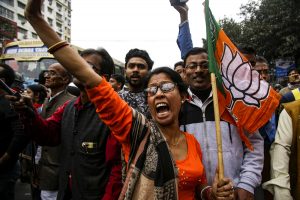Amidst the chaos of the pandemic this month, Bangladesh is marking the 50th anniversary of its liberation from Pakistan. In the last half-century, Bangladesh has gone from a basket case of poverty to a land of economic promise, often cited as a model of uplift around the world.
Bangladesh’s liberation had significant consequences beyond its own borders. It inaugurated in many ways the most significant paradigm shift in Indian foreign policy – one that persists in New Delhi to this day.
The 1960s was a tumultuous decade in India, marked by famines, wars, and the death of the country’s long-serving and charismatic first prime minister, Jawaharlal Nehru. In the years that followed Nehru’s death, his daughter and eventual successor as prime minister, Indira Gandhi, decided that India had to change course – and the 1971 war proved to be her litmus test.
In the aftermath of the disastrous war with China in 1962, and the increased threat of a possible nexus between China and Pakistan, Prime Minister Gandhi sought to fulfil two objectives: first, to rebuild the Indian army’s morale, and second, to secure a strategic victory that would weaken the threat from Pakistan.
Soon enough, the opportunity came in the form of discontent among Bengali nationalists in East Pakistan, which soon blew up into an all-out war as the Pakistani army escalated the tensions into violence.
In the run-up to the war, Gandhi overhauled one of Nehru’s most sacrosanct foreign policy tenets: non-alignment. In order to preempt the potential threat of America’s involvement on Pakistan’s behalf, the Indian prime minister signed a treaty of cooperation with the Soviet Union.
The strategic shift worked. Britain and America sent naval ships into the Bay of Bengal to deter India’s military actions, but the Soviet specter all but drove them away.
For New Delhi, the success of that experiment bore lessons that stay on to this day. Even as the Soviet Union dissolved and gave way to an era of American preeminence, India remained doggedly wedded to its defense and military ties with Moscow. For better or worse, the Nixon administration’s committed friendship with Pakistan continues to fester in India’s memory. Despite New Delhi’s increased cooperation with Washington in recent years to counter Chinese influence in the Indo-Pacific, India has striven to seek a balance between its ties with the U.S. and Russia.
Gandhi’s focus on India’s neighborhood also continues to define the nation’s foreign policy aspirations, even decades later. As prime minister, Nehru pursued a more globalist agenda in foreign policy, mediating conflicts far and wide, from the Congo to Korea. But by securing a significant victory in Bangladesh – more so in the wake of a tumultuous decade – Gandhi established India’s strategic primacy in South Asia as its foremost foreign policy goal.
In the decades that followed, much of India’s strategic thinking has remained centered on the immediate neighborhood, rather than building upon Nehru’s more globalist aspirations.
Yet, politically, the 1971 war has not delivered all that it had promised.
Bangladesh’s liberation had promised to put paid to the experiment of religious nationalism in South Asia. Back in 1947, many international commentators had predicted India’s eventual balkanization under the weight of its diversity. But in 1971, it was the supposedly less diverse Muslim state of Pakistan that broke up. Bangladesh went on to proclaim itself a secular state.
Meanwhile, in Pakistan, feelings of vengeance simmered against India, as fanatics hoped to “bleed India with a thousand cuts.” Under President Zia-ul-Haq, that policy was given further shape through more robust support for secessionists in Indian Kashmir and Punjab.
Just as significantly, in the aftermath of the loss in Bangladesh, Zia also set in motion a process of Islamization in Pakistan, seemingly in the hope that the most effective way to avoid a repeat of 1971 was to counter Pakistan’s still rich ethnic diversity with ever more Islam. In 1978, Zia announced that Islam would prevail over the country’s laws and constitution. The following year, courts begin to apply Shariah laws more enthusiastically.
Zia’s militant radicalism spawned years of violence and antagonism between India and Pakistan. In India, national security troubles on the border with Pakistan fed suspicion towards Muslims more generally and boosted the counter-movement of Hindu nationalism. Three years after Zia’s death – and not long after genocidal violence in Kashmir had driven out the Hindu and Sikh minority – Hindu nationalist militants demolished a landmark mosque in the town of Ayodhya, which they said was built on the ruins of a temple to Lord Ram.
Today, those divisions run deeper than ever across the region. Bangladesh’s own commitment to secularism is under increased assault from Islamist radicals – many of whom have descended ideologically from those who had sided with Islamabad during the 1971 war. In India, Kashmir has been stripped of the autonomy that had been promised to its leaders more than 70 years ago. Hindu nationalism is redefining India’s national identity in unprecedented ways and has soured relations with Bangladesh, where Islamist radicals are attacking the Hindu minority, apparently in retaliation.
When Bangladesh became a free secular state 50 years ago, South Asia seemed primed to move on from religious nationalism. But the tragedy in the region is that politics has all but gone in the opposite direction.

































